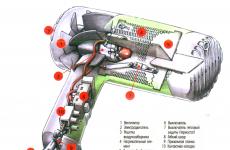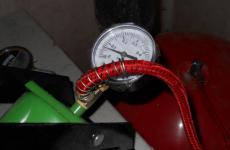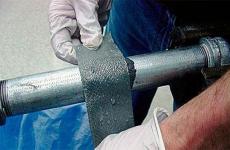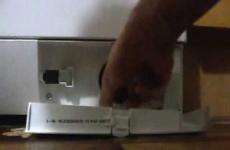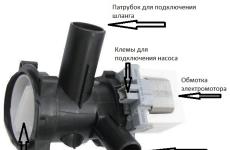Heating boiler pressure
Many users of gas boilers are faced with such a problem when their unit "refuses" to turn on and heat the coolant. That is, it can be seen from the indicators that the boiler is operational, but it is in a standby state or switched to emergency mode. This situation often occurs due to the pressure drop in the boiler. Moreover, its value falls below the manufacturer's acceptable standard. The drop in pressure can be either sharp or slow.
How does a sharp drop in pressure occur?
Before such a disappointing phenomenon for the system, a double-circuit or single-circuit wall-mounted boiler works as usual. The features of his work are as follows:
- The sensors show that all indicators except the temperature of the coolant correspond to the norm... The water or antifreeze is chilled and needs to be heated.
- The automatics work, the burner turns on.
- The coolant temperature rises very quickly. At the same time, the pressure inside the system rises rapidly. This is reported by the pressure gauge of a double-circuit heating boiler.
- Due to rapid heating, the pressure easily rises to the upper critical mark, to which the security group immediately reacts. It begins to relieve pressure by draining the coolant. And here the main point arises: in the absence of any breakdowns, the pressure compensates for the expansion tank, and only a small amount of water can drain into the sewer, but if there are difficulties, too much coolant is poured out.
- The boiler, heating the water to the desired temperature, turns off and waits until it cools down.
- The coolant cools down. At the same time, the pressure decreases. Since there is less water, the pressure drops below the level that was before the start of the double-circuit boiler. It is clear that when large volumes are dumped, this pressure drops too much. Automation determines that it is less than the minimum rate and does not turn on the heating boiler.
Part of this the situation can be smoothed out by the make-up pipe... However, cold water must be supplied when the boiler burner is not working. The liquid from the water supply is supplied until the pressure is restored. Then the heating boiler turns on, the above process is repeated, and the unit is waiting for the next make-up.
The most common reason why the pressure drops sharply is a faulty expansion tank.
How a diaphragm tank works
He is a container with a rubber membrane inside... It can be balloon-shaped or diaphragm-shaped. This diaphragm divides the expansion tank into two parts. The volume of the parts depends on the pressure inside the system. One part is permanently filled with nitrogen or special gas. Nitrogen is under pressure. In some tanks, this value reaches 0.9-1 bar. The second part can be filled with water or empty.
According to many videos, the work of a membrane tank should be like this:
- With an increase in pressure inside the system water begins to flow into the expansion tank... It fills it as much as the network pressure exceeds the nitrogen pressure. The membrane holds the entire load all this time.
- There is less water in the system and the pressure does not rise. That is, all the requirements for the normal functioning of the heating network are met.
- If the heating boiler heats up further and the pressure continues to rise, the automation reduces all the pressure difference that the expansion tank cannot compensate by draining the coolant. However, the volume of the drained water is small.
- The heating boiler turns off, the antifreeze becomes colder, the pressure drops, the antifreeze is pushed into the network by nitrogen and normalizes the pressure inside the system.
Which leads to a large pressure drop
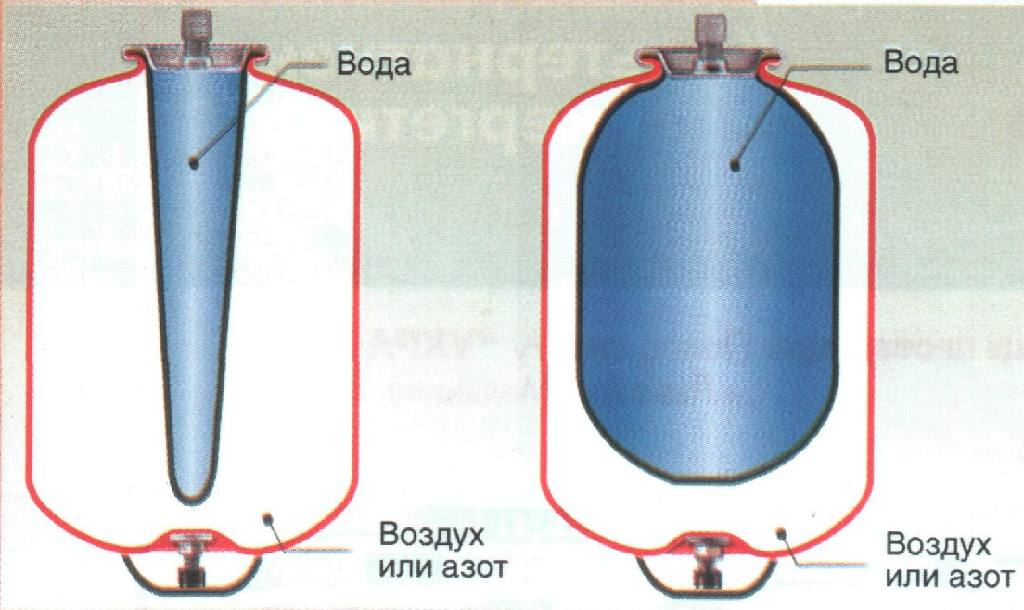 Problems start when nitrogen or other gas comes out of the tank. He can do this through a special nipple. The more nitrogen capacity is lost, the less pressure it can compensate for. This is because the coolant that has entered it can no longer return back.
Problems start when nitrogen or other gas comes out of the tank. He can do this through a special nipple. The more nitrogen capacity is lost, the less pressure it can compensate for. This is because the coolant that has entered it can no longer return back.
Over time, the liquid fills the expansion tank completely. It is clear that because of this there is not enough water in the heating system. The deficiency is compensated for through the make-up pipe... This creates conditions for the discharge of a large amount of coolant when the pressure rises to the maximum allowable mark.
To identify the presence of problems with the tank, perform the following actions:
- turn off the heating boiler;
- antifreeze is drained;
- remove the expansion tank;
- measure the nitrogen pressure. The resulting indicator is checked against the figure in the documentation. He must be equal to her.
If there is little gas, it must be pumped in.
The diaphragm tank can also lose its function due to rupture of the diaphragm. This situation is the most deplorable, since the only way to solve the problem is to replace the container.
Causes of slow pressure drop
This situation may be due to:
- Latent leakage in pipes or radiators of the heating system.
- The presence of an air bubble in the heating system.
- Leaks in the boiler heat exchanger.
- Incomplete closing of the coolant drain valve.
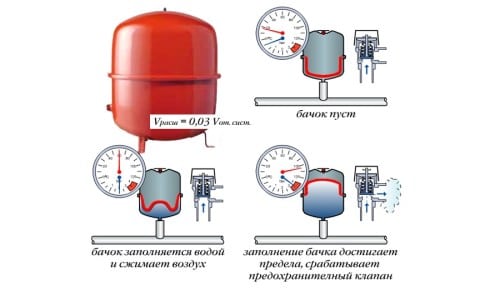
Latent leakage and air in the heating system
Leakage of the coolant can be carried out through:
- Connection of pipes and radiators.
- Connection (if the radiators are sectional).
- Cracks that have appeared in any part of the heating system.
To make sure that there is such a reason, you need conduct a thorough check of all pipes and radiators... True, this can be done when all highways are open or are behind protective screens. That is, they are not hidden in the wall. You need to look for water drips or rust. It may be that the coolant flows out and immediately evaporates. It is impossible to find such a problem area using visual assessment.
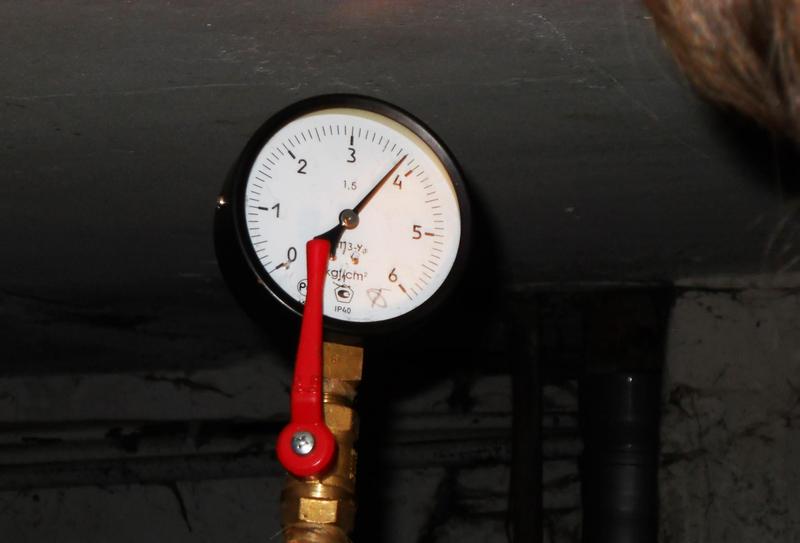
If the system is hidden in a wall or floor, you need to call a specialized service. You can also find the leak yourself. They do it like this:
- The coolant is drained from the system.
- Connect the compressor to the network and pump in air to check if it holds it.
- Listen for whistles. It forms when air escapes through cracks or leaks. This whistle should be strong enough.
- You need to listen to all heating communications... Then the air is released and problem areas are eliminated.
The problem with the presence of air in the heating network may appear when there are breakdowns of pipes or radiators, or when the system is filled with coolant and not all the air has been deflated.
The pressure drops due to the fact that over time, air escapes through special valves, and the volume of antifreeze becomes too small. The performance is increased by adding coolant.
Leakage in the heat exchanger
It arises due to microcracks in this unit of the heating boiler. The reasons why cracks appear can be as follows:
- Wrong.
- Physical deterioration.
- Manufacturing defects.
It is very difficult to identify such a problem, because the heat exchanger heats up from the flame, and the water that has flowed out of it evaporates. Then she goes out through the chimney. In addition, water practically does not flow out through the cooled heat exchanger, because the size of the microcrack becomes smaller than the size of the microhole in the heated unit. Only specialists can identify this reason.

